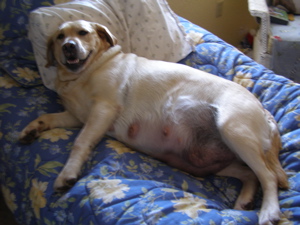designed this pattern to match both yellow and black Labrador hair.
Why do people buy Labrador x Poodle mixes?
The "Labradoodle" craze is sweeping the country, and I would just chuckle and shake my head if it weren't for the fact that dogs are paying for the public's whims with their lives. The real story behind Labradoodles are they began in Australia by some breeders who sincerely were trying to produce a non-shedding dog that could be used for service work. They understood that it takes at least five generations of breeding to be able to set traits that will breed true. What they found was the experiment didn't work--the dogs not only didn't have an appropriate temperament for service dog work (like a well-bred Labrador does), they shed. There are still a few dedicated breeders producing Labradoodles (NOT a Lab x Poodle cross, but a purebred Labradoodle, with at least five generations of purebred Labradoodle behind them), but they will be the first to tell puppy buyers that many of their dogs shed. They come in different coat types. They *know* this because they have worked with this breed for generations.
So, the "Labradoodles" that most people are buying--as well as the Goldendoodles, Puggles, and any other "designer" breeds flooding the internet these days--are simply expensive mutts. If you disagree, take this quiz. Some of them may well be cute, but some are really ugly. Some may be sweet, while some are hyper, neurotic messes. That's the problem with first generation mixes, you have no idea what the puppy is going to grow up to be. To say they are free of genetic diseases is totally false, as the people breeding these dogs aren't even checking them for genetic issues. Dogs inherit the same problems their parents carry, and there's little chance the sire and dam are from well-bred lines, meaning the cross bred pups are indeed quite likely to have genetic problems. The people breeding these mixes are not in it because they love and want to improve the "breed," as most responsible breeders are. They are producing these dogs to make money off a gullible public. They are simply not telling the truth.
The other thing that bothers me about this "designer dog" craze is the people who buy these dogs. There have always been impulse buyers, they are the people that keep puppy mills in business. Shame on them. Some people buying these mixes may actually feel that they have done their research, but ended up being suckered by lies. That is unfortunate, as it keeps the untruthful breeders in business. But, the bottom line is most Labradoodle buyers are motivated by one thing--the prospect of owning a dog that doesn't shed. Hello. DOGS SHED! If you aren't enough of a dog lover to share your home with a little hair, don't get a dog. If you are a dog lover and don't like dog hair, vacuum! It's not hard, and a small price to pay for the privilege of sharing your tidy home with a beautiful, healthy, well bred Labrador. I recommend an Oreck.
Enough from me, here is the official statement from the Labrador Retriever Club.
"The Labrador Retriever Club, Inc is dedicated to the health and welfare of the Labrador Retriever breed while conserving the original breed function - that of a "working retriever." A purebred dog offers to his owner the likelihood that he will be a specific size, shape, color and temperament. The predictability of a breed comes from selection for traits that are desirable and away from traits that are undesirable. When a breed standard or type is set, the animals within that breed have less heterozygosity than do animals in a random population.
A Labradoodle is nothing more than an expensive mongrel. Because the genetic makeup is diverse from the Poodle genes and the Labrador genes, the resultant first generation (F1) offspring is a complete genetic gamble. The dog may be any size, color, coat texture and temperament. Indeed Labradoodles do shed. Their coat may be wiry or silky and may mat. Body shape varies with parentage but tends to be lanky and narrow. Behavior varies with the dog and within a litter with some puppies poodle-like in attitude and others somewhat like the Labrador Retriever.
These crossbreds are a deliberate attempt to mislead the public with the idea that there is an advantage to these designer dogs. The crossbred dogs are prone to all of the genetic disease of both breeds and offer none of the advantages that owning a purebred dog has to offer."
Frances O. Smith DVM, Ph.D.
LRC, Inc. Board of Directors
